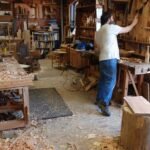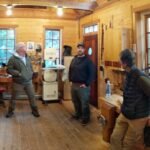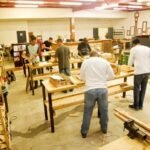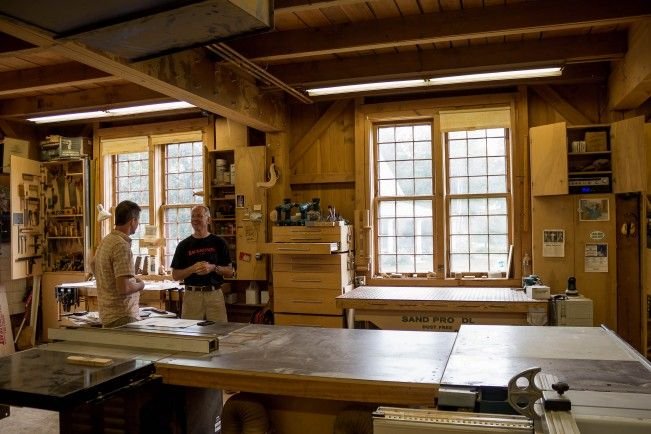Finding My Way in Woodworking
You know how some days just feel set on a certain path? Like when you wake up, stretch out in your favorite chair with a cup of coffee, and you’re convinced today’s the day you finally tackle that woodworking project that’s been haunting you? I mean, that was me, bright-eyed and ready to take on a new challenge, all at once feeling like both a proud craftsman and an absolute rookie.
So, I had this idea—I wanted to build a coffee table. Simple, right? Just a couple of planks, some glue, and a good ol’ saw. I decided on some beautiful reclaimed oak that I’d picked up from a local mill. You know that smell of freshly cut wood? It’s like a warm hug on a cold day—sweet, rich, and a touch earthy. But, boy, do I wish I’d spent a little more time planning.
Getting Ahead of Myself
I was too excited, honestly. I’d never tackled anything like this, and I thought, “What’s the worst that could happen?” Spoiler alert: plenty. I rushed to the garage, grabbed my circular saw—an old Ryobi model that’s seen better days—and started measuring. Now, if there’s one lesson I’ve learned, it’s this: measure twice, cut once. But me? I checked once, maybe once and a half, and cut like I had my own workshop show.
Well, surprise, surprise! When I laid out the pieces, they didn’t match up. One leg was a good half-inch shorter than the others. I almost threw my tape measure out the window. How could I mess up something that seemed so straightforward?
Turning Mistakes Into Moments
Sipping my coffee, I sat there, staring at the pile of wood, feeling a mix of frustration and confusion. I’m pretty stubborn, so instead of giving up, I decided to adjust. I grabbed one of my trusty wood clamps and some scrap wood. That became a support for the shorter leg. It was a real “fix it on the fly” moment. I chuckled, feeling a bit like a mad scientist of the workshop. Who knew that mistakes could lead to… well, let’s just call it creative adaptation?
After sorting that out, I moved on to the sanding. Oh, sweet Jesus, the sanding. Have you ever spent hours just rubbing your hands raw on wood? I used a DeWalt sander because I figured now was as good a time as any to splurge a little. The sound of the sander was almost hypnotic—like a low hum that made everything else fade away, but my arms started to scream at me, “What are you thinking?!”
The Finish Line… or Not
Now came the fun part—finishing. I thought I’d go with a simple polyurethane finish. You should’ve seen me, pouring that stuff into a tray, all concentrated-like, and then splashing some over the side. I’m pretty sure I invented a new kind of slip-n-slide in my garage that day. But you know what? Once I got it on the wood, there was something almost magical about it.
And when I finally stepped back to admire my work, I felt that familiar mix of pride and disbelief wash over me. I mean, it was not perfect by any means—there were some rough edges, and let’s not even talk about the glue that pooled up on one side—but it felt like, well, me.
I almost gave up more than once, doubting my ability and skills while grappling with all those mishaps. But when it all came together, I found myself laughing with joy, maybe even a little surprised. I actually built something!
The Community Connection
It was during that journey that I found out about the Woodworkers Association of NSW. I think a little light bulb went off in my head when I realized there was this community I could tap into—not just to learn techniques but also to find folks who’ve been through similar experiences. They get it, you know? The mistakes, the triumphs, the coffee-stained plans. They have all the tools I dream of owning one day, and killing time at the meetings, sharing stories feels like the perfect next step.
I remember seeing a post about a member who turned a disaster into a beautiful wooden sculpture. She’d miscalculated and ended up cutting wood too short for the project she intended. Instead of tossing it, she carved it into something entirely new. Sitting here, I wish I could’ve gotten that advice earlier—learning how to see failure as art rather than just “failure.”
Wrapping It Up
So, what’s the takeaway from all of this? For anyone thinking about diving into woodworking or any craft, it’s simple: just go for it. Don’t be afraid of making mistakes. Embrace them! They might just lead you down a creative rabbit hole you never knew existed. Life’s too short to worry about perfect cuts or flawless finishes. What matters most is the process, the mess, and the memories you carve out along the way.
You might just find yourself laughing when it actually works out—or even when it doesn’t. And trust me, the next time you step into your workshop, it’ll smell of sawdust and possibilities. Cheers to those moments!








